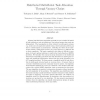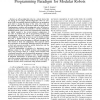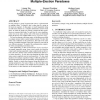453 search results - page 88 / 91 » Communication Concepts for Mobile Agent Systems |
ICRA
2003
IEEE
14 years 25 days ago
2003
IEEE
Existing task allocation algorithms generally do not consider the effects of task interaction, such as interference, but instead assume that tasks are independent. That assumptio...
CODES
2007
IEEE
14 years 1 months ago
2007
IEEE
Networks on Chip (NoC) have emerged as the design paradigm for scalable System on Chip communication infrastructure. A growing number of applications, often with firm (FRT) or so...
ROBOCOMM
2007
IEEE
14 years 1 months ago
2007
IEEE
—A self-reconfigurable robot is a robotic device that can change its own shape. Self-reconfigurable robots are commonly built from multiple identical modules that can manipulat...
INFOCOM
2010
IEEE
13 years 6 months ago
2010
IEEE
—In many scenarios network design is not enforced by a central authority, but arises from the interactions of several self-interested agents. This is the case of the Internet, wh...
SIGECOM
2011
ACM
12 years 10 months ago
2011
ACM
In many settings, a group of agents must come to a joint decision on multiple issues. In practice, this is often done by voting on the issues in sequence. In this paper, we model ...



